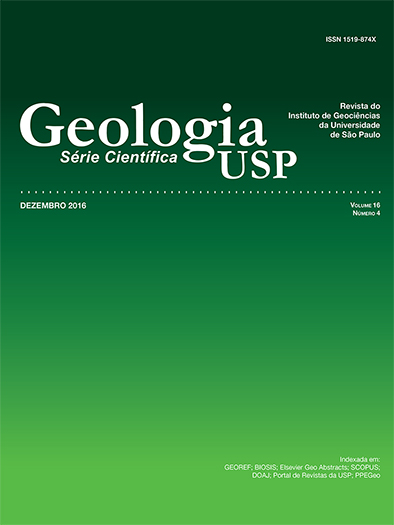Floristic similarities of the Artinskian Siderópolis Member macroflora, Rio Bonito formation (Paraná Basin, Brazil) with Cisuralian paleofloras of India
DOI:
https://doi.org/10.11606/issn.2316-9095.v16i4p53-64Keywords:
Glossopteris, Western Gondwana, Eastern Gondwana, Artinskian.Abstract
This contribution focuses on the relationship between the Siderópolis Member paleoflora and Indian Gondwanan paleofloras, especially with those of the Cisuralian stages, thus providing additional criteria for the correlation of Western and Eastern Gondwanan coal successions in the lower Permian interval. Despite the large number of species in common with the Karharbari Stage (Sakmarian) flora, the Siderópolis paleoflora exhibits a higher percentage and diversification of the genus Glossopteris, which is less expressive in the Karharbari Stage floras, while the declining Gangamopteris-Noeggerathiopsis complex in Siderópolis Member paleoflora still dominates the associations of Karharbari Stage. However, the floristic composition of the lower level of the Barakar Stage (Artinskian), despite having fewer species in common with the Siderópolis paleoflora, exhibits the characters of the latter vis-à-vis the dominance and diversity of the genus Glossopteris over the Gangamopteris‑Noeggerathiopsis complex, which decreases both in diversity as well as in abundance in the lower Barakar, similar to what occurs in the Brazilian paleoflora. The decline of the icehouse stage and the similar latitudinal position of the Gondwanan regions compared in the present study seem to have acted as important factors to the development of similar vegetation patterns in coal floras from Western (Brazilian) and Eastern (Indian) Gondwana during the Artinskian.
Downloads
Published
Issue
Section
License
Authors who publish in this journal shall comply with the following terms:
- Authors keep their copyright and grant to Geologia USP: Série Científica the right of first publication, with the paper under the Creative Commons BY-NC-SA license (summary of the license: https://creativecommons.org/licenses/by-nc-sa/4.0 | full text of the license: https://creativecommons.org/licenses/by-nc-sa/4.0/legalcode) that allows the non-commercial sharing of the paper and granting the proper copyrights of the first publication in this journal.
- Authors are authorized to take additional contracts separately, for non-exclusive distribution of the version of the paper published in this journal (publish in institutional repository or as a book chapter), granting the proper copyrights of first publication in this journal.
- Authors are allowed and encouraged to publish and distribute their paper online (in institutional repositories or their personal page) at any point before or during the editorial process, since this can generate productive changes as well as increase the impact and citation of the published paper (See The effect of Open Access and downloads on citation impact).





